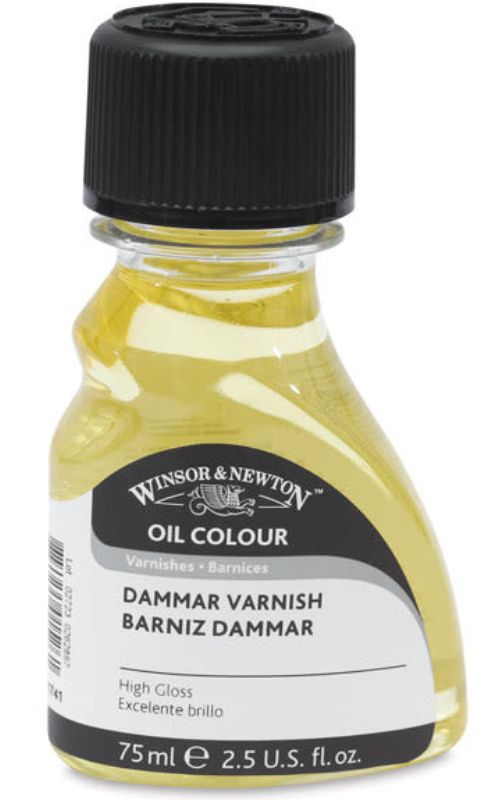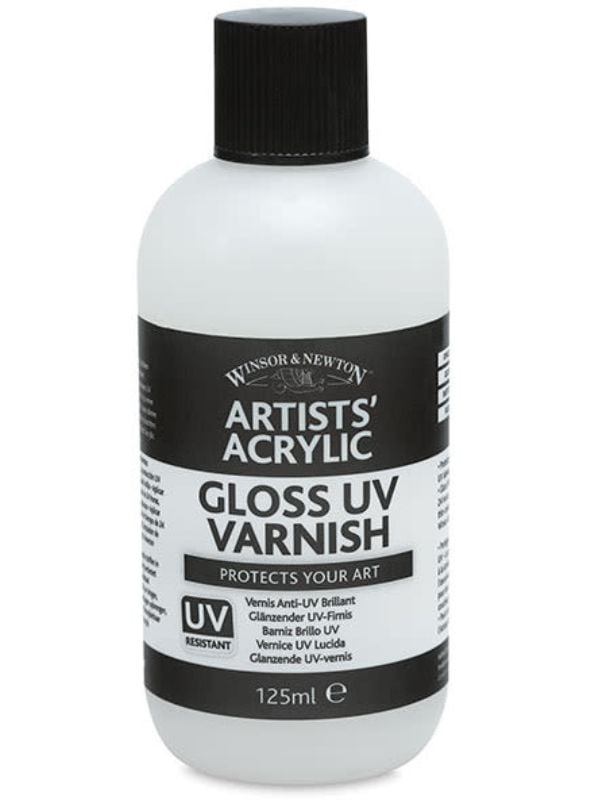Though not a required material to use on your painting. Painting varnish is a great way to protect your painting from dust and UV rays, as well as keep it from yellowing. It can also help to pull out the vibrancy of the colors used in your painting.
By varnishing a painting, instead of dust particles and elements affecting the painting itself, the coat of varnish takes the brunt of the wear. So that when it is time to clean a painting, the old varnish can be removed and then re-applied with a fresh coat. Therefore, restoring the painting to look just as fresh as it did the day it was finished! *This is the method that many art restorers use when working with paintings.

What is painting varnish?
Varnishes for painting are a protective coating that you can apply to your finished work. In painting and art, there are different varieties of painting varnishes that include; picture varnish, retouch varnish, and mixing varnish. All of which are used for different stages of a painting.
In this article we will be focusing in on picture varnishes, which are varnishes you can use for the final coat of a painting. It provides a protective layer and helps to produce a uniform finish to the piece.
What types of painting surfaces can be varnished?

Varnish works well for oil and acrylic paintings. This is because the painted surface is relatively thick.
Varnish does not work well with watercolor, pastel, gouache or drawings as the paper will absorb the varnish as well as the paint, charcoal or graphite. Also, the varnish will never be able to be removed.
Removable and non-removable varnish
There are two basic varieties of painting varnish – removable and non-removable. Removable varnishes can be taken off with chemicals or solvents without damaging the paint layer underneath. Non-removable varnishes become chemically bonded to the surface and can only be removed by sanding or stripping the painting.
Therefore it is recommended to use removable varnish as this allows for the painting to be cleaned and revarnished in the future. Due to the fact that with non-removable varnish, all of the dirt that is collected on the varnish layer will have to permanently stay.
Natural resin varnishes for paintings
Natural resin varnishes are made from a variety of natural resins including amber, copal, dammar, mastic, and shellac.

Natural resin varnishes can provide a high level of protection against UV light, moisture, and other environmental factors that can damage paintings. Furthermore they can enhance the appearance of a painting by giving it a deep, lustrous sheen.
Varnish made from mastic resin

Mastic varnish is among the oldest in the history of art. Comprised of resins from Pistachio trees, it has a very high level of resistance to yellowing, making it an ideal varnish. However, it is not recommended to use mastic varnish as your final coating.
Damar
Damar is a traditional varnish that was first used in the 19th century. It has been known to yellow and darken with age, but if applied correctly it can be used as a final picture varnish. Just make sure to apply thin coats, to avoid crazing.

Soft and hard copal resins
Soft and hard copal resins are used to create a natural resin varnish. However over time, soft and hard copal resins become more and more difficult to remove so it could never be revarnished in the future. It is not recommended to use copal resin varnishes as a final coating for your painting.
Synthetic painting varnish

There are many synthetic varnishes now available. Since they are a more recent invention we have not been able to see how they react to the test of time. However, they offer many advantages over traditional varnishes.
Advantages of synthetic varnishes
- Provide a more durable finish.
- They are less likely to yellow over time (as far as we know at this time).
- Easy to apply, as well as to buff to a high shine.
- Is easier to remove (if necessary).
Most popular synthetic painting varnish
Gamvar is one of the most popular synthetic varnishes on the market and is a great oil painting varnish. Created by Gamblin, it is a water-based varnish. Which makes it less smelly to apply and easier to clean up.
Acrylic finishing varnish
Another popular option is an acrylic finishing varnish. These varnishes come in both water and oil-based formulas. Which offer the same advantages as Gamvar but they can be used for both oil and acrylic paintings.
Optical finishes of varnishes
Each painting varnish will affect how your painting surface looks – specifically as some create a glossy sheen. Most painters choose their varnish based on what type of sheen it provides.
Glossy painting varnishes

These varnishes will provide a high-shine, almost wet look to your painting. They can really make colors “pop” and give your work an extra dimension of depth. Because of the high shine, though, these varnishes are not ideal for every type of painting. If the surface of your painting has texture to it, or if you want more of a subtle look. You will want to look at using a different type of varnish.
Semi glossy or satin
These varnishes provide a moderate shine – enough to make colors look richer and more vibrant, but not so much that it overpowers the painting. This is a good all-purpose varnish, and can be used on most types of paintings.
Matte

These varnishes will provide a more muted finish, without the high shine of glossy varnishes. This can help subdue colors and give your painting a softer overall look. It is easier to see a painting with a matte varnish as there is no glare present like there can be with a glossy varnish.
Add a table listing the glossiest versus more matt varnishes….
Recommended oil painting varnishes
Winsor and Newton Dammar Varnish (Glossy finish)

Winsor and Newton Dammar varnish is an all around good traditional natural oil painting varnish to use. However, I would recommend using it for smaller paintings. As it has a tendency to dry quickly compared to other varnishes.
You want to be able to cover your entire painting before it starts drying. This helps you to create a smooth application. Also take note that this varnish has a very high gloss – if that is not what you are looking for then steer clear of it!
Another thing to note, is that it’s best to wait until your painting is fully dry before applying dammar varnish. This can take about 6 months… So if you’re in a hurry to varnish your painting then it is best to use a different varnish.
Gamvar (Satin, Gloss and Matte)

Gamvar varnish is a synthetic resin varnish, developed in partnership with the National Gallery of Art. It is available in three different finishes – glossy, satin and matte.
However, you’ll need to wait until your painting is dry to the touch before you use gamvar varnish. Which might take a couple weeks or months depending on how thick the paint application on your piece is.
Mastic picture varnish – Old Holland (Glossy)

This is a traditional natural varnish for oil paintings, made by Old Holland. It creates a high gloss surface and tends to yellow slightly. Mastic picture varnish is created using pure mastic resin, mixed and dissolved in white spirit.
The manufacturer recommends waiting 1 year to apply the mastic picture varnish.
Recommended varnishes for acrylic painting
Liquitex acrylic finishing varnishes (glossy, satin, matte)

This acrylic varnish is available in multiple different types of finishes – glossy, satin and matte. It has great resistance to chemicals, water and ultraviolet radiation. It will do a good job to protect your acrylic paintings.
Winsor and newton artists acrylic varnish (glossy, satin and matte)

Another great acrylic varnish that will do well to protect your artwork, is this W&N artist’s acrylic. Also, it is a strong UV resistant varnish so you don’t need to worry about any light damage.
It’s available in a variety of different surface finishes – glossy, satin and matte.
Recommended varnishes for water soluble oil paints
Winsor and newton water mixable varnish (glossy, matte and satin)

Use Winsor and Newton painting varnish for paintings made with water mixable oils. It is non-yellowing and UV resistant. It comes in a range of three different surface finishes – glossy, matte and satin.






8 thoughts on “What is Painting Varnish? What to Know About Varnishes Starting out”
Thank you for explaining the difference between varnishes. Very helpful.
My question to you is(if you can help) how do you finish an oil painting that you started last year but never finished. I. Would love to hear your thoughts. Thank Pat
You are very welcome Patricia! Glad this is helpful 🙂 In regards to finishing a painting that was started a year ago you should be able to pick up where you left off. Depending on what point you left it can be a little hard to find ones place in it for a little bit. However, one thing that is helpful is to mix up the exact same color of the area where you are going to work back into your painting. Doing this helps you to more easily get your footing right away in the process.
Do you still have Liquid as a oil painting finish.
Hi Lorraine! I am assuming you meant liquin? If so, liquin unfortunately doesn’t work well as a finish for oil paintings. It tends to turn yellow over time and is not removable.
Thanks for this comprehensive article on varnishes. I have managed to get some liquitex matte lacquer but have not used it yet. I will use it ony acrylic paintings. Not sure about using it on oils. Thanks again.
Hi Warren, Great to hear from you. Thank you! your question regarding varnish was the inspiration for me to do this research and create the article. So thank you! If it is a polymer acrylic varnish then it cannot be used on oil paintings. If you are not sure if it is polymer based it should say on the product info either online or the bottle. But a non polymer acrylic varnish should be able to be used on both oil and acrylic paintings.
Thank you Elizabeth for this helpful article. I didn’t know about Gamvar and I think I will love using it for my oil paintings in the Satin finish. I don’t apply my paint very thickly so I can get my paintings varnished much quicker this way – a matter of weeks, not months.
Hi Myra, So glad this was helpful for you. Yes! With Gamvar you can cut your waiting time down a bit when it comes to varnishing. I personally also prefer the satin finish as well as try to avoid my paintings being too shiny.